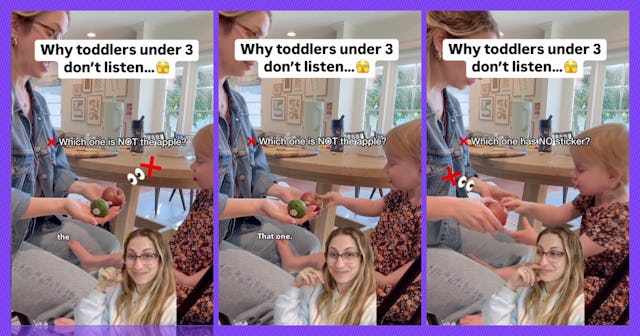Your Toddler Literally Doesn't Understand The Word 'No’ In Sentences, According To A Speech Therapist
If you’re talking to your 3-year-old kid using “negative sentences,” you might be getting really frustrated.

Does it ever feel like your toddler just doesn’t get the meaning of “no?” You say, “Don’t jump on the couch!” and there they are, jumping happily, like you never said a word. It might feel like an act of silly, childlike defiance, but according to one expert, most toddlers’ language skills are simply not developed enough for them to understand what negatives mean.
Speech therapist and mom Melissa Minney, @raisinglittletalkers, shared a video to Instagram Reels explaining to parents that their child may not understand the meaning of “no” — and offering methods to help teach them.
“Did you know that toddlers under three do not fully understand the words “no” and “not” in sentences?” she asked. “I'm a speech therapist, and I'll prove it. Watch this.”
Minney showed a clip of her and her daughter. She holds out an apple and a lime, and asks her daughter which one is not an apple. Her daughter points to the apple. Minney then asked which fruit does not have a sticker on it — the apple has a sticker, while the lime does not. Her daughter picks the sticker-ed apple.
Breathe a sigh of relief, parents, you’re not going crazy! They really just don’t get “no” in this context! But why?
“Research tells us that young children under three can incorrectly interpret these negative sentences as affirmatives, meaning they only pay attention to the rest of the sentence and not the negative part,” Minney explained. “So if you said no climbing on the stairs, they would just hear climbing on the stairs.”
Small problem: toddlers are always doing something they’re not supposed to do. It’s kind of their whole thing. So, how are you supposed to handle that?
“When you want your child to stop doing something, tell them what to do instead, like, “Let's sit on the couch,” or, “The couch is for sitting,” Minney said. “If it's a matter of safety, try using a simple “no” or “stop,” and then physically move their body so they learn the meaning of those words. Then once they're safe, you can follow up with what they can do instead.”
Now, toddler parents, you might be thinking, “But my kid loves to say no to brushing their teeth.” Yes, “no” is many toddler’s favorite word. But what Minney’s talking about is the confusion that more complex sentences can produce. It’s like searching “cake recipe no eggs” — the search algorithm will likely still pick up the word “eggs,” and show you a result or two containing them.
Every kid’s language development is a little different, so your child may or may not be in this boat. Minney clarified in the comments that kids may still disobey out of a lack of impulse control, or as a means of testing boundaries.
She suggested trying the experiment from the beginning of the Reel with your toddler to see if they understand “no” or “not.” The key, she explained, is to use two objects that you are confident your child knows what they are.
If you didn’t know this helpful bit of information, you’re not alone! Many parents in the comments expressed their surprise, while others shared the funniest instances of their toddlers not taking “no” for an answer.
“My 2 year old LOVES to throw things for fun, I say ‘No throw! Do not throw things!!!’ So now he picks something up and screams NO THROW! ... then proceeds to throw it and laughs 🤦🏼♀️🤦🏼♀️🤦🏼♀️,” shared one user.
“This seems true. Just last night I told mine to stop biting AND SHE PURPOSEFULLY KEPT BITING. I'm going to try this next time,” said another.
So, maybe your toddler is still developing parts of their language, or maybe they just feel like biting you. If you find out, let us know.